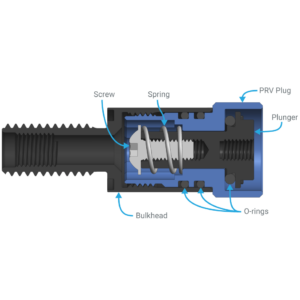Hello hello subsea friends! We’ve built up a bunch of internal excitement for this one… introducing the Pressure Relief Valve and Backfill Adapter!
You might be wondering why you’d even need an automatic pressure relief valve. Our enclosures already come with a manual vent and it’s been working great for years. A few years back (in 2019!), we introduced a locking update to our 2″ Watertight Enclosure Series with plans to roll out locking versions of the 3″ and 4″ Series soon after, but our launch schedule changed dramatically in early 2020 (hi, covid). Among other features, the next generation of watertight enclosures has a locking cord that secures the flange to the tube.

Tube and flange with the locking cord installed.
The locking cord means that the enclosure is more secure and has less risk of an end cap coming off, even if some pressure builds up inside the tube. However, it also means that if an excessive amount of pressure builds up in the tube it can create an unsafe situation. That could be due to the buildup of gasses from a chemical reaction like something catching on fire, or from a slow leak into the enclosure while at depth followed by a quick return to the surface. Those cases are both fairly unlikely, but we want to make sure you’re super safe, so we designed the PRV!
Along with the PRV, we have the new Backfill Adapter, which is a neat little attachment that we’ve designed for use with the PRV and is the reason the PRV looks the way that it does. With the new vacuum adapter, the Backfill Adapter allows you to do two things. First, with a vacuum pump, enclosures can be pulled to vacuum and sealed at vacuum. Second, with some additional equipment, enclosures can be filled with an inert gas like nitrogen, which is often done when it’s necessary to guarantee that there’s no moisture or humidity in an enclosure.
Last, we’re also making updates to the Enclosure Vent and Plug and to the Vacuum Plug. They’re updated to share some of the same parts as the PRV. The new vent looks similar to the PRV now, but instead of the automatic relief valve, it just has a simple plug.
We have a new guide to go along with this launch – check it out!

Pressure Relief Valve Installation and Usage
That’s all we’ve got for now! As always, we can’t wait to see how you use the PRV and Backfill Adapter!


@emiller I am planning to purchase a watertight enclosure and working to figure out which accessory components we want/need. I understand a pressure relief valve is strongly recommended, but it’s not clear to me what the difference is between the PRV and the M10 enclosure vent. Is there any reason we might need both, or is either one sufficient?
Thanks!
Hi Alex,
The PRV automatically releases internal pressure if it builds to a level higher than external pressure - this is important when the enclosures are used with batteries, as a fire or other event could turn the water-tight enclosure into a hazard without a pressure relief system to vent gasses!
If used with standard electronics, the PRV is not necessary. A standard M10 vent plug allows you to assemble the enclosure and have the air that is compressed by inserting the o-ring flange escape. This makes installing the locking cord easier as you’re not fighting the compressed air internally.
Thanks Griselda! I saw your other post about your consulting services - if we end up needing your expertise, I’ll be sure to reach out. I appreciate the information!